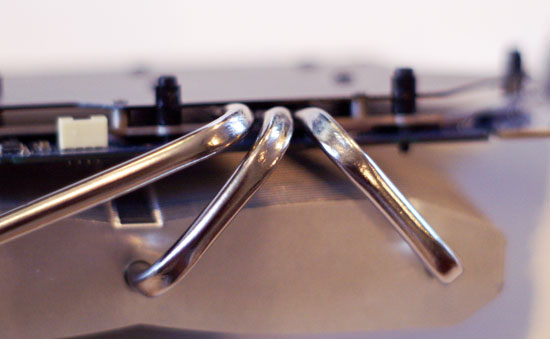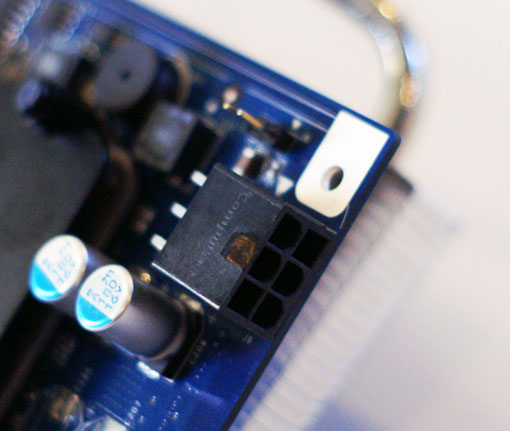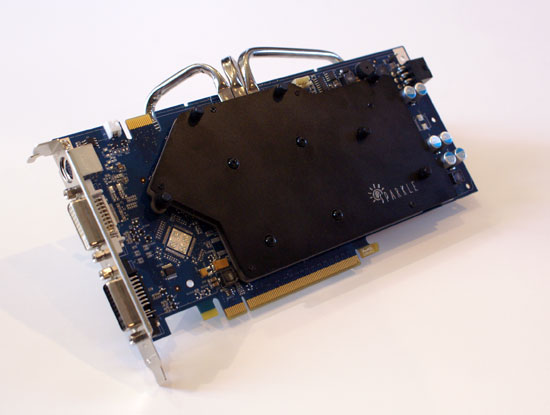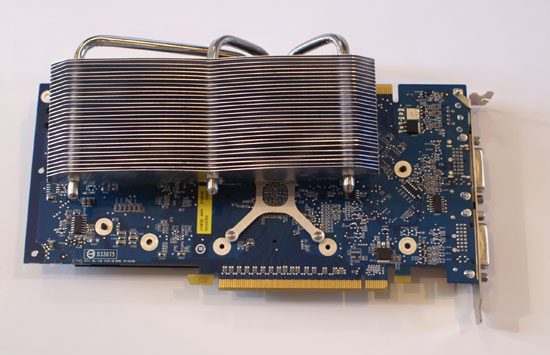Sparkle 8800 GT Passive: The Fastest Silent GPU in the World
by Anand Lal Shimpi on November 29, 2007 12:00 AM EST- Posted in
- GPUs
The Sparkle 8800 GT Passive
This article is called a preview because the 8800 GT Passive just isn't out yet, but Sparkle assures us that it'll be available soon from TigerDirect at $319.
As we've already mentioned, the 8800 GT Passive is bone stock running at a 600MHz core clock, 1.5GHz shader clock and 1.8GHz memory data rate. In other words, this passively cooled best will perform identically to the 8800 GT we reviewed at the end of October. Impressive, if it works.
The front of the card is amazingly simple, there's a black plate where we'd normally see a massive heatsink and a small Sparkle logo, well, sparkles, in the lower right. Sparkle keeps the tough job of cooling away from the front, instead all we've got here is a plate that attaches three heatpipes to the G92 GPU.
The heatsink wraps around the back of the card, keeping it closer to the CPU in your system. The idea is to keep the heatsink in the path of a large case or PSU fan to help keep it cool since the card has no fan of its own. The heatpipes do a great job of moving heat away from the GPU but heatsinks work best if they have some air carrying heat away from the fins.

The heatsink design itself is pretty simple; there are a lot of fins made out of a very lightweight aluminum to keep the card's weight down. Despite the larger heatsink the card doesn't seem to weigh any more than a stock 8800 GT. On the flip side you've got to be extra careful with the 8800 GT Passive because these fins are easily damaged, so if you were planning on a sporty game of discus with your 8800 GT don't make it this one.

The rest of the card's attributes are standard 8800 GT fare. There's a 6-pin PCIe power connector on one end, two dual-link DVI ports at the other. S-Video out if you want blurry output to a TV, and a single SLI connector if you want to really push the limits and try two passively cooled 8800 GTs in a single system.















55 Comments
View All Comments
qamca - Sunday, January 20, 2008 - link
Well, it occurs to me that the authors of this article have no intention on getting the coolest, but in somewhat beating the record of highest temperature out of this configuration....And if your PC case is so small and in such a mess and so crowded, I don't see why would anyone buy a passive cooled performance graphics card like this one... In fact I don't see why would anyone build any performance configuration in a case like this one??
Another test I read has successfully overclocked this card to 695/2000 without reaching 85C.
All you need is a tidy case and a well thought trough airflow in it.
So keep your pants on all you people scared of getting burned...
jay401 - Saturday, December 8, 2007 - link
"NVIDIA’s original target for the 8800 GT was $199 for the 256MB version and $249 - $259 for the 512MB version,"WHOAH WHOAH WHOAH. In your original review article, about the 512MB model, you said you expected prices would be $200-250 for the card. And in reality the 512MB WERE available for as low as $219 on launch day. So bullcrap to this revisionist "$249-259 for the 512MB version".
Nice attempt at trying to re-write history though. I'm sure NVidia appreciates it.
The reality is the reference design 512MB models were to be available as low as $200 (and we saw deals as low as $209 crop up within the first two weeks after launch). It was the over-clocked models that would approach $250-260 on the high end.
zshift - Monday, December 3, 2007 - link
google 111 c in f and you'll see that the card is running at 231.8 F. water boils at 212 F/100 C. that means you should never handle that card immediately after playing a game (i.e., u play a game, shut down pc, then switch out components, cards, etc.), or else you'll be holding a blistering hand, literally. so be careful out there if you buy this card.natrap - Wednesday, December 5, 2007 - link
111C is the temperature at the GPU where the sensor is located. The temperature on the surface of the card and the heatsink will be somewhat lower.BucDan - Saturday, December 1, 2007 - link
Sparkle is so bs to me..that cooler looks exactly like a thermalright hr-01 seriously... at least its not lke the hr-03/r600 lol...what losers gotta copy thermalright with their ideas.natrap - Saturday, December 1, 2007 - link
sorry for the multiple posts. silly thing kept spitting out error so it didn't look like it posted.natrap - Saturday, December 1, 2007 - link
I agree with Cerb. The fact that it reached 111C and did not fail is a good sign. And that was recorded with the case fans off in a poorly ventilated case. I'm gonna get this for an Antec Solo which has a single 120mm case fan at the rear over the CPU. I'd expect a temp a little lower. As for such high temps affecting the life of the card, well it does come with a 12 month warranty. If it hasn't failed in that time running close to 24/7 then the chance of it failing soon after isn't going to be a great deal higher.Cerb - Saturday, December 1, 2007 - link
If you want to add a fan, just get another card. The idea of a passive card is that your case can sufficiently move air to cool it, without adding another noise-maker.They put this GPU in a scenario that would be insane for anyone to actually try, and it DID NOT FAIL. In a decent case, with decent air flow and cable management, it should work excellently, without any modding.
Sure, you can get an aftermarket cooler and cool it better. In fact, you can probably do better passive, with something like the S1. But, that means more work, and more cost. Adding a fan, however good it cools it, basically defeats the purpose, though.
natrap - Saturday, December 1, 2007 - link
I agree with Cerb. The fact that it reached 111C and did not fail is a good sign. And that was recorded with the case fans off in a poorly ventilated case. I'm gonna get this for an Antec Solo which has a single 120mm case fan at the rear over the CPU. I'd expect a temp a little lower. As for such high temps affecting the life of the card, well it does come with a 12 month warranty. If it hasn't failed in that time running close to 24/7 then the chance of it failing soon after isn't going to be a great deal higher.natrap - Saturday, December 1, 2007 - link
I agree with Cerb. The fact that it reached 111C and did not fail is a good sign. And that was recorded with the case fans off in a poorly ventilated case. I'm gonna get this for an Antec Solo which has a single 120mm case fan at the rear over the CPU. I'd expect a temp a little lower. As for such high temps affecting the life of the card, well it does come with a 12 month warranty. If it hasn't failed in that time running close to 24/7 then the chance of it failing soon after isn't going to be a great deal higher.